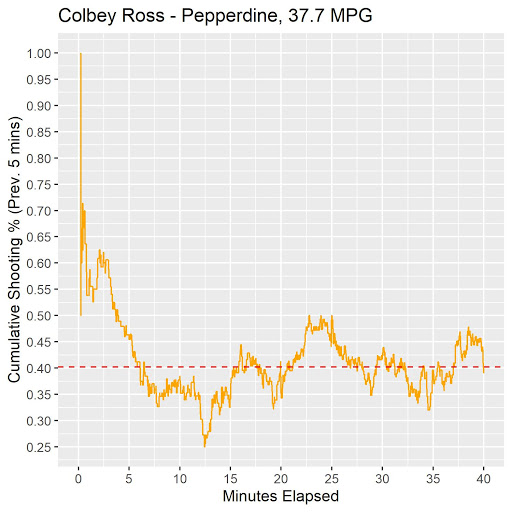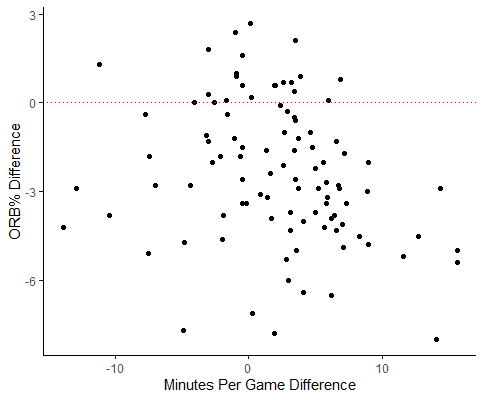Welcome back! In my last article, I looked at the top 20 players in terms of offensive rebounding percentage (the percentage of available offensive rebounds a player got while he was in the game) and compared their ORB% to their offensive ratings (the number of points a player produces for every 100 possessions). If you missed the article, you can find it
here. We saw that all of these players generally had very high O Ratings which were helped by their offensive rebounding. Yet, those who had the highest O Ratings generally were very good in other areas of offense as well such as shooting efficiency measured by effective field goal percentage (a modified field goal percentage where three-pointers count for more as they're worth more points).
I felt like the next step would be to switch over to looking at defensive rebounding percentage (calculated the exact opposite of offensive rebounding percentage). You can probably already guess that I'll be comparing this to defensive ratings to see the role that defensive rebounding plays in DRtg. Defensive ratings are like offensive ratings except they're the points allowed by a player per 100 possessions. Like offensive ratings, there's a complicated formula behind them that I won't mention here. Also, they're less accurate than O Ratings because they're much more heavily influenced by how good a player's entire team is defensively. Still, it'll be interesting to look at. Like the last article, defensive rebounding percentage (DRB%) and D Rating data are from Fox Sports.
Here's the graph comparing DRB% to D Rating:
Here's the complete list of players: Kevin Marfo - Quinnipiac
RJ Williams - Boise State
Patrick Harding - Bryant
Dave Bell - Jacksonville
Emanuel Littles - North Alabama
Nico Carvacho - Colorado State
James Dickey - UNC Greensboro
Aaron Carver - Old Dominion
Dwight Wilson - James Madison
Austin Wiley - Auburn
James Butler - Drexel
John Mooney - Notre Dame
Nathan Knight - William & Mary
Joel Soriano - Fordham
Kai Edwards - Northern Colorado
Ahsan Asadullah - Lipscomb
Yoeli Childs - BYU
Elyjah Goss - IUPUI
Tyler Bey - Colorado
Carlos Dotson - Western Carolina
Lowest DRB%, Low DRtg
To start off the analysis, we'll begin in the bottom left corner which is where we find the players with the lowest defensive rebounding percentage and the lowest defensive ratings. We'll focus on Tyler Bey and Joel Soriano. Even though these players have some of the lowest defensive rebounding percentages of the group, they're still only about 7% lower than the national leader, Kevin Marfo. Not too shabby. Since the lower the defensive rating is, the better (you want to allow as few points per 100 possessions as possible), let's see if other factors besides strong defensive rebounding has led to these players being such good defenders.
Tyler Bey - Colorado
Bey is no stranger to the list of top defensive rebounders as he was second in the country last year in DRB% at 35.9%. His numbers came down a bit this season at 29.9%, but his overall defensive rating still improved. This is because Bey was able to double his steals per game from 0.8 to 1.6 and he maintained a steady 1.2 blocks per game. Another factor in the improved DRtg was that he became more disciplined in his fouling as he only averaged 2.6 fouls per game this season. Perhaps the most important factor though, was that Colorado as team got better defensively. As mentioned in the intro, a player's defensive rating is closely tied to his overall team's defensive rating. Colorado improved from allowing 97.5 points per possession in 2018-19 to allowing 94.6. Bey was well below the team average in both of these seasons, but the team improvement certainly helped him out a bit. It's clear that Bey has a strong defensive skill set beyond just rebounding as his steals, blocks, and foul discipline shows. It's no surprise that he took home the Pac-12 Defensive Player of the Year award and projects to be drafted in large part due to his defensive ability.
Joel Soriano - Fordham
Unlike the established junior Bey, Soriano came off the bench and had fluctuating playing time for much of his freshman season for the Rams. However, he began to come into his own and started the last 11 games of the season. He only averaged 4.6 defensive boards per game, but in the limited minutes that he played this season, this translated to an excellent defensive rebounding percentage. Similarly, his block percentage was very solid (6.4%) despite him not having very many total blocks (only 0.9 per game). Offensively, Soriano struggled a bit with a 45.5% effective field goal percentage, but his efficiency improved as he experienced a larger role over those last 11 games. Soriano's excellent defensive numbers this season were largely driven by his DRB% and block% being so high in the restricted role that he had for most of the season. If he can maintain those rates and continue his better shooting efficiency while taking on more minutes this coming season, it will bode well for the team from the Bronx.
Lowest DRB%, Highest DRtg
Now we move to the top left of the graph which is where players who had a tough time defensively, but still managed to excel on the boards appear. This would suggest that players in this region lean on defensive rebounding to make up for struggles in other defensive areas. The only player in this area to look at is IUPUI's Elyjah Goss, and we'll see what caused his DRtg to be so high.
Elyjah Goss - IUPUI
At first glance, it's confusing to see how Goss could have such a high defensive rating. Nothing stands out as a glaring defensive weakness. He averaged 0.5 steals per game, 1.0 blocks per game, and 2.6 fouls per game. While these numbers don't necessarily wow you, they're not too far off from some of the numbers that our defensive standouts above were achieving. Thus, it's not the stats themselves that hurt Goss. Instead, it was partially the fact that he played 31.1 minutes per game for his team. His per-game stats ended up being very similar to Soriano above, but it took Soriano far less game-time to achieve them which is why he appears so much better from a DRtg standpoint. The more important factor though is that IUPUI wasn't a great defensive team last year, and we've already seen the influence of the team DRtg on an individual's rating. The Jaguars had one of the worst team defensive ratings at 111.7 points allowed per 100 possessions. Goss was actually well below this at 106.9, so while it was his worst DRtg in his three-year career thus far, we see that it certainly wasn't all his fault.
Highest DRB%, Highest DRtg
We're going to skip the top right corner as nobody falls within that region and we'll end this article with the bottom right. These are players who are clearly some of the best defensive rebounders in the minutes that they play and who also play solid overall defense to have such low defensive ratings. Four players could reasonably be looked at here (Bell, Harding, RJ Williams, and Marfo). I'm going to limit to the analysis today to just Bell and RJ Williams. Fear not Bryant and Texas A&M/Quinnipiac (if they don't hate him for leaving) fans, Harding and Marfo will be mentioned in a future article.
Dave Bell - Jacksonville
Bell started his career in his home state of Ohio playing at Ohio State. After his sophomore season, he decided to take his talents down south to Florida to play for the Dolphins. He had a solid first season in the Atlantic Sun, but enjoyed a true breakthrough this past season. He experienced over a 16 point increase in his offensive rating (100.3 to 116.6) and over 9 point decrease in his defensive rating (98.4 to 89.0). As a coach, there's not much more you can ask for from your senior center. Defensively, he posted a very impressive 8.8% block rate, good for 43rd in the country. He also had 7.3 rebounds per game which is made more impressive by his high DRB%. It's a shame that Bell couldn't play another season to continue his upward trajectory. He'll certainly be a player that the Dolphins will miss next season.
RJ Williams - Boise State
Williams came in at #2 of the players with the best defensive rebounding percentage at 35.9%. Like Bell, he also transferred in for his final two seasons, but came from the JUCO ranks instead of another Division I program. He too experienced quite an impressive leap in both offensive and defensive ratings. His offensive rating climbed 18.6 (!) points and his defensive rating dropped by about 4 points to a nice 92.4 points allowed per 100 possessions. He actually experienced a slight decrease in both steals and blocks per game and even had an uptick in fouls per game. Thus, the improvement in DRtg seems to be driven a lot by Boise's team improvement from 2018-19's 103.3 points allowed per 100 possessions to this past season's 98.6. Williams still remained an above-average defender for his team this season and while not the focus of this article, his efficiency on offense was a tremendous help to the Broncos.
Overall Thoughts:
Clearly, we see that individual DRtg depends far more heavily on team defensive success than ORtg relies on team offensive success. This dependency made analysis a bit more tricky as it was tough to tell how much a player's DRtg improvement was his own doing or was due to the team. Nevertheless, we got a glimpse of why Tyler Bey is becoming a frequently talked about draft prospect. We also saw a player in Soriano who looks to take on a larger role next season, and a player in Goss who will hope his team is able to get more on his level defensively. Lastly, we were able to identify two players in Dave Bell and RJ Williams who deserve recognition for really elevating their games in their final season of college hoops.
Thanks so much for reading this far, I hope you enjoyed it!























